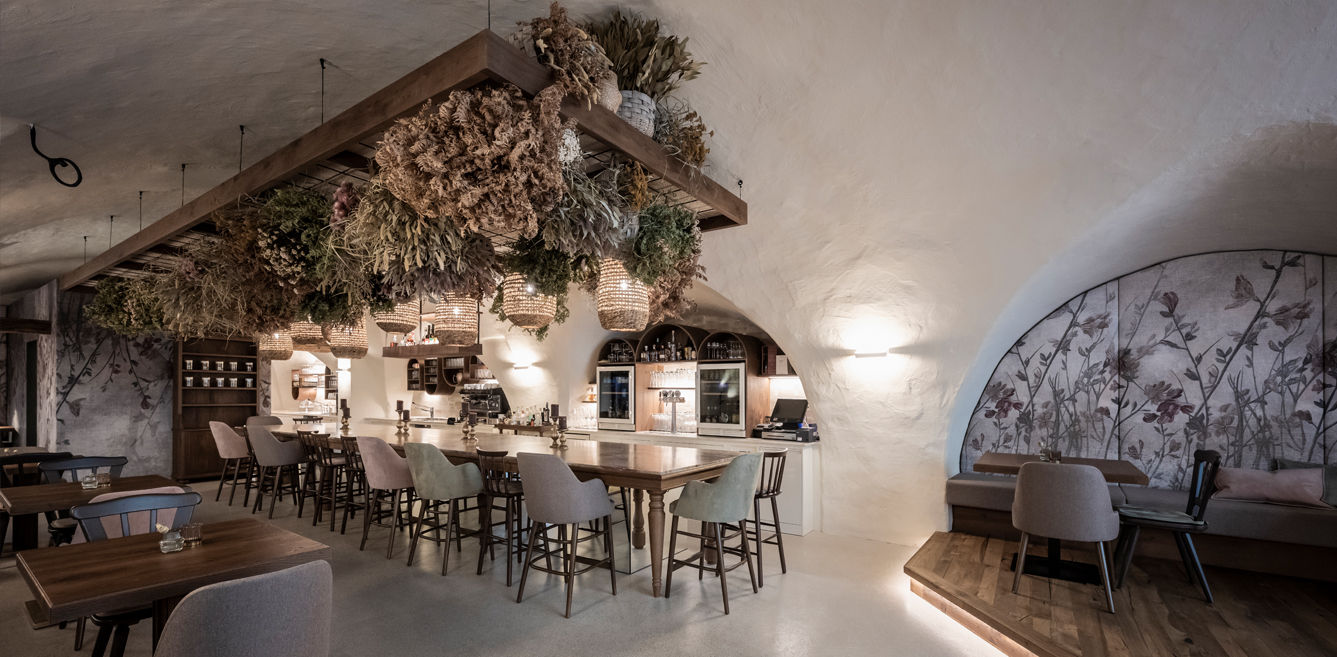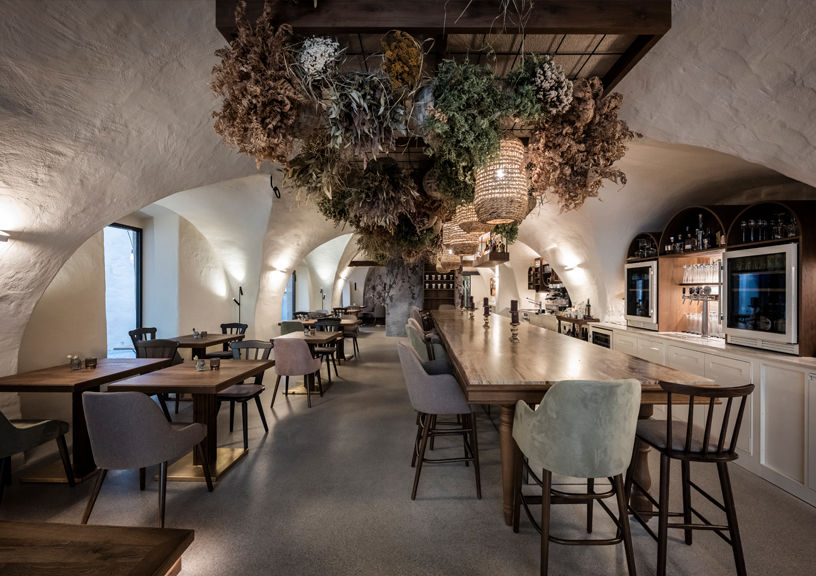

Bogen Bistro
Bogen Bistro: An ancient workshop in Bolzano gets a new lease of life by noa*, as it’s transformed into a welcoming bistro poised between historical heritage and contemporary finesse


Atrading hub for Italian and German speaking merchants since the 13th century, Bolzano’s mercantile past echoes through the arcades of Via Portici, the city’s main axis. The goods that would later reach the whole of Europe were stored in the warehouses here. Like Via Portici, the northern parallel street of Via Dr. Streiter has also preserved much of its original appearance; today, it still passes through three medieval stone arches. The street was mentioned for the first time in a document from 1498 and overlaps the old northern moat of the first town centre.
About halfway down the street is a house that is hard to miss—with only two storeys, it is one of the lowest in the neighbourhood. An external staircase with an open corridor and round-arched portals provide access to the east side of the building, breaking up the compact street front. This house has been the backdrop for noa*’s latest interior design project. “The house has a fascinating past that goes back centuries and overflows with life and variety,” explains Stefan Rier, founder of noa* and lead architect of the project. “It has been in the hands of the Teutonic Order, a goldsmith named Hanns in the 15th century, the town secretary Ennthofer in the 16th century, and a long line of families thereafter. With our intervention, we wanted Bolzano’s mercantile history to emerge clearly from these walls.”
The project involved the space on the ground floor where shoemakers, carpenters, carters, and wood and fruit merchants worked in the 19th century, and where the first restaurant on the street was established later. Although the building preserved its charming original architecture, it had deteriorated over time. The Mayr family, current owners of the building, entrusted the interior design firm with the restoration and interior planning for a new destination—the Bogen Bistro.
HISTORICAL HERITAGE
The strong relationship with history was crucial in the definition of the project—both because the house is under monumental protection and because the design team wanted to emphasise to the fullest the original architecture of the arches, to which the bistro itself pays homage with the name ‘Bogen’, German for ‘arch’. On the exterior façade, the intervention consisted of a careful replastering in smoky white and an enlargement of the entrance arch. Here, a new tripartite black metal window follows the segmental arch and allows good natural lighting while providing an essential and timeless design. During their research into the former called Via dei Carrettai, the designers found a painting by Richard Wolff depicting life at the turn of the 18th and 19th centuries. In the foreground of this fascinating snapshot, they were surprised to see the entrance arch to what is now Bistro Bogen.
For the interior, the underlying idea was to emphasise the four arches, which on both sides rhythmically mark the almost 19-metre depth of the room. To do so, the designers worked on both the horizontal and vertical dimensions. In the first case, the existing internal height difference was resolved with an oak platform at the entrance, while a grey-beige polished screed was chosen for the floor. In this way, there is no strong colour contrast with the walls, and the harmony of the shades enhances the whole space. On the other hand, the lighting was designed such that the spotlights gently emphasise the curves of the arches. Except for the two tables at the end of the room, there are no pendant lights and only floor lamps provide additional lighting.
BOHEMIAN ATMOSPHERE
During the first meetings between the clients and the interior designers, which focused on the ambience of the Bogen Bistro, the clients’ desire to have a romantic, bohemian-style atmosphere emerged. In addition, the owner of the house, Roswitha Mayr, wanted to give the space a personal touch with her handcrafted and artistic talents in the form of floral compositions. noa* took up these ideas and structured the design around a pivotal element—a welcoming 7-metre long counter placed under a ceiling of flower baskets. “The flower vault immediately became the highlight of the interior design. The upturned baskets filled with dried flowers are a suggestive image that symbolises the transience but at the same time the beauty of life,” explains Silvia Marzani, interior designer at noa*.
The long table as a convivial and informal solution in gastronomic ambience is a recurrent motif for the interior design firm. In this case, the counter is also a worktop on the right side, without any stools and housing technical compartments. Other interesting details make this piece of furniture unique—the six legs are each different from the other and suggest an improvised table that a family might have made for itself. A mirror covers the central base and makes it disappear into the room. The top is a slab of Nacarado stone, chosen for its distinct veining and warm colour. Above the table, Roswitha’s personal creation is the large floral composition that seems to pour from the ceiling. The hanging rattan lamps, which also recall the basket motif, find their place among the flowers.
COZY ALCOVES
The shared space of the large counter contrasts with the intimacy of the small tables on the left side of the bistro, sheltered by the arches and overlooking the alley. The feeling of privacy is further accentuated in the first pair of arches, with seating built into the recesses and walls covered in fabric with an elegant floral print. The niche closing off the room is also designed in the same way. In a constant dialogue between past and present, new seats in wood and fabric alternate with newly lacquered vintage chairs.
There are two service areas: the kitchen, which has been completely renovated and is located at the end of the room, and the toilets. These have been accommodated in a box, clad with perforated metal panels, on which the same floral motif of the arches has been printed. In this way, the technical requirements of acoustics have been combined with the venue’s aesthetics; the insulation panels are not visible under the perforated metal surface. The designers managed to create a consistent design with a strong contemporary character within a centuries-old structure—a step into Bolzano’s present and past at the same time.
Photo credit: Alex Filz
Factfile
Project: Bogen Bistro, Bolzano, Italy
Interior Designer: noa* network of architecture, Italy
Client: Roswitha & Benjamin Mayr
Intervention: Renovation
Surface area: 188 sq m
Year of completion: 2021
Are you a corporate employee spending 10+ hours in an ordinary cubicle that's fused in…
Modern Indian homes are no longer bound by their physical vicinity. They have outgrown our…
Häcker Kitchens, a brand synonymous with quality and innovation, has a rich legacy that spans…
In this home designed by Sonal R Mutha and Aniketh Bafna, founders and principal designers…
Essentia Home’s journey in redefining luxury interiors took a bold new step as it opened…
Retail design is a balancing act. Between creating spaces that attract and those that sell,…